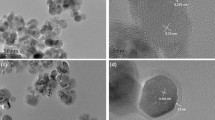Abstract
Chemical fixing of xanthene dye (eosin Y) on the surface of TiO2 electrode was carried out by modifying the electrode with silane-coupling reagent to obtain stable dye-sensitized TiO2 electrode. Such silane modification can not only evidently enhance the stability of dye-sensitized TiO2 electrode but also improve the energy conversion efficiency of the assembled cells by increasing short-circuit photocurrent (J SC) and open-circuit photovoltage (V OC). It was found that the improvements of cell performances differ depending on the composition of the electrolyte. The optimum cell of the cell performance was achieved in the electrolyte with 0.5 mol/L TBAI/0.05 mol/L I2/EC:PC(3:1 w/w), yielding J SC of 4.69 mA·cm−2, V OC of 0.595 V, fill factor (FF) of 0.64 and η of 1.78%. Different spectroscopic techniques including UV-Vis spectra, fluorescence spectra, EIS and dark current measurements were employed to derive reasonable analysis and explanations.
Similar content being viewed by others
References
Oregan B, Gratzel M. A Low-cost, high-efficiency solar-cell based on dye-sensitized colloidal TiO2 films. Nature, 1991, 353: 737–740.
Hagfeldt A, Graetzel M. Light-induced redox reactions in nanocrystalline systems. Chem Rev, 1995, 95: 49–68
Wang P, Zakeeruddin SM, Moser JE, et al. Stable new sensitizer with improved light harvesting for nanocrystalline dye-sensitized solar cells. Adv Mater, 2004, 16: 1806–1812
El Mekkawi D, Abdel-Mottaleb MSA. The interaction and photostability of some xanthenes and selected azo sensitizing dyes with TiO2 nanoparticles. Int J Photoenergy, 2005, 7: 95–101
Hara K, Horiguchi T, Kinoshita T, et al. Highly efficient photon-to-electron conversion with mercurochrome-sensitized nanoporous oxide semiconductor solar cells. Sol Energy Mat Sol C, 2000, 64: 115–134
Hara K, Sato T, Katoh R, et al. Molecular design of coumarin dyes for efficient dye-sensitized solar cells. J Phys Chem B, 2003, 107: 597–606
Hara K, Tachibana Y, Ohga Y, et al. Dye-sensitized nanocrystalline TiO2 solar cells based on novel coumarin dyes. Sol Energy Mat Sol C, 2003, 77: 89–103
Wang ZS, Cui Y, Dan-Oh Y, et al. Thiophene-functionalized coumarin dye for efficient dye-sensitized solar cells: Electron lifetime improved by coadsorption of deoxycholic acid. J Phys Chem C, 2007, 111: 7224–7230
Wang ZS, Cui Y, Hara K, et al. A high-light-harvesting-efficiency coumarin dye for stable dye-sensitized solar cells. Adv Mater, 2007, 19: 1138–1141
Tokuhisa H, Hammond PT. Solid-state photovoltaic thin films using TiO2, organic dyes, and layer-by-layer polyelectrolyte nanocomposites. Adv Funct Mater, 2003, 13: 831–839
Nazeeruddin MK, Humphry-Baker R, Officer DL, et al. Application of metalloporphyrins in nanocrystalline dye-sensitized solar cells for conversion of sunlight into electricity. Langmuir, 2004, 20: 6514–6517
Konno A, Kumara GRA, Kaneko S, et al. Solid-state solar cells sensitized with indoline dye. Chem Lett, 2007, 36: 716–717
Horiuchi T, Miura H, Uchida S. Highly efficient metal-free organic dyes for dye-sensitized solar cells. J Photoch Photobio A, 2004, 164: 29–32
Schmidt-Mende L, Bach U, Humphry-Baker R, et al. Organic dye for highly efficient solid-state dye-sensitized solar cells. Adv Mater, 2005, 17: 813–818
Fujihira M. Photocell uusing covalently-bound dyes on semiconductor surfaces. Nature, 1976, 264: 349–350
Abe R, Hara K, Sayama K, et al. Steady hydrogen evolution from water on eosin Y-fixed TiO2 photocatalyst using a silane-coupling reagent under visible light irradiation. J Photoch Photobio A, 2000, 137: 63–69
Moser J, Graetzel M. Photosensitized electron injection in colloidal semiconductors. J Am Chem Soc, 1984, 106: 6557–6564
Nguyen TV, Lee HC, Yang OB. The effect of pre-thermal treatment of TiO2 nano-particles on the performances of dye-sensitized solar cells. Sol Energy Mat Sol C, 2006, 90: 967–981
Suri P, Mehra RM. Effect of electrolytes on the photovoltaic performance of a hybrid dye sensitized ZnO solar cell. Sol Energy Mat Sol C, 2007, 91: 518–524
Bando KK, Mitsuzuka Y, Sugino M, et al. Attachment of an organic dye on a TiO2 substrate in supercritical CO2: Application to a solar cell. Chem Lett, 1999, 853-854
Kim S S, Yum J H, Sung Y E. Improved performance of a dye-sensitized solar cell using a TiO2/ZnO/eosin Y electrode. Sol Energy Mat Sol C, 2003, 79: 495–505.
Wang Z S, Sayama K, Sugihara H. Efficient eosin Y dye-sensitized solar cell containing Br−/Br3 −. electrolyte. J Phys Chem B, 2005, 109: 22449–22455
Kazuhiro Sayama, Maki Sugino, HideKi Sugihara, et al. Photosensitization of porous TiO2 semiconductor electrode with xanthene dyes. Chem Lett, 1998: 753–754
Gregg B A, Pichot F, Ferrere S, et al. Interfacial recombination processes in dye-sensitized solar cells and methods to passivate the interfaces. J Phys Chem B, 2001, 105: 1422–1429
Spivack J, Siclovan T, Gasaway S, et al. Improved efficiency of dye sensitized solar cells by treatment of the dyed titania electrode with alkyl(trialkoxy)silanes. Sol Energy Mat Sol C, 2006, 90: 1296–1307
Kern R, Sastrawan R, Ferber J, et al. Modeling and interpretation of electrical impedance spectra of dye solar cells operated under open-circuit conditions. Electrochim Acta, 2002, 47: 4213–4225
Argazzi R, Bignozzi C A, Yang M, et al. Solvatochromic dye sensitized nanocrystalline solar cells. Nano Lett, 2002, 2: 625–628
Pollard JA, Zhang D S, Downing J A, et al. Solvent effects on interfacial electron transfer from Ru(4,4′-dicarboxylic acid-2,2′-bipyridine)(2)(NCS)(2) to nanoparticulate TiO2: Spectroscopy and solar photoconversion. J Phys Chem A, 2005, 109: 11443–11452
Author information
Authors and Affiliations
Corresponding author
Additional information
Supported by the National Research Fund for Fundamental Key Project (Grant No. 2006CB202605), High-Tech Research and Development Program of China (Grant No. 2007AA05Z439) and National Natural Science Foundation of China (Grant No. 20873162)
About this article
Cite this article
Zhou, Y., Li, X., Zhang, J. et al. Performances improvement of eosin Y sensitized solar cells by modifying TiO2 electrode with silane-coupling reagent. Chin. Sci. Bull. 54, 2633–2640 (2009). https://doi.org/10.1007/s11434-009-0440-8
Received:
Accepted:
Published:
Issue Date:
DOI: https://doi.org/10.1007/s11434-009-0440-8




